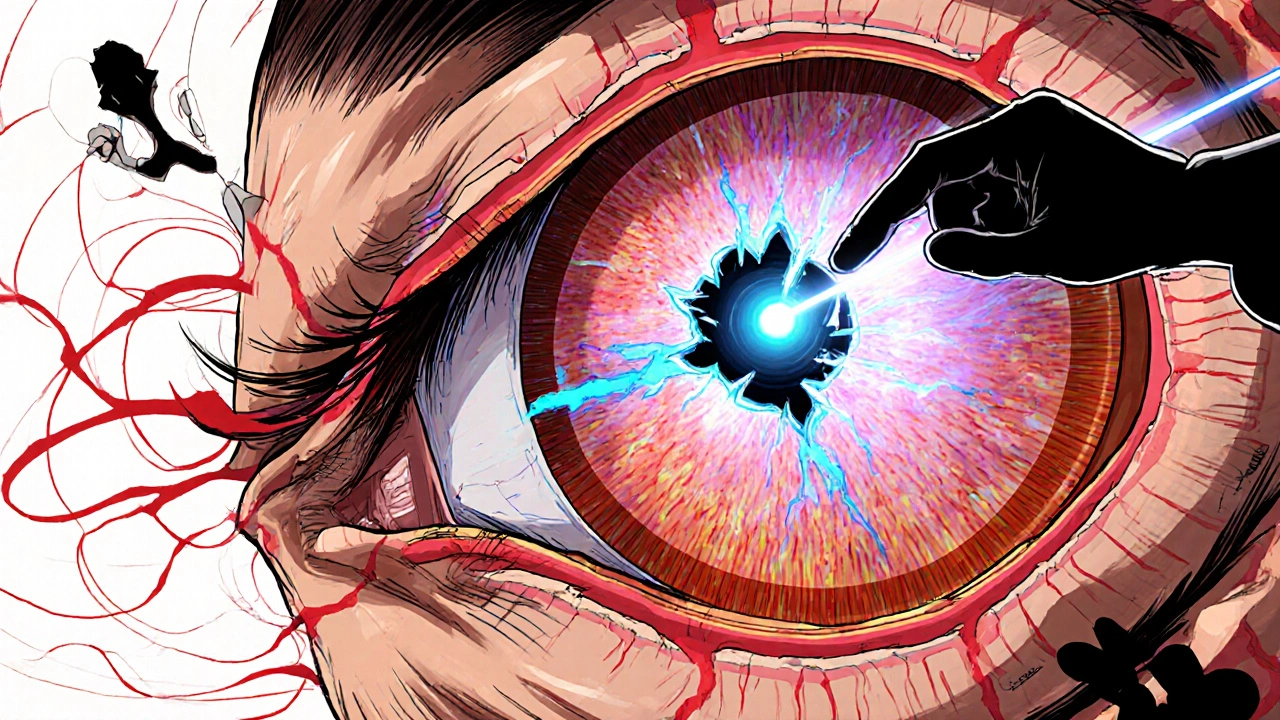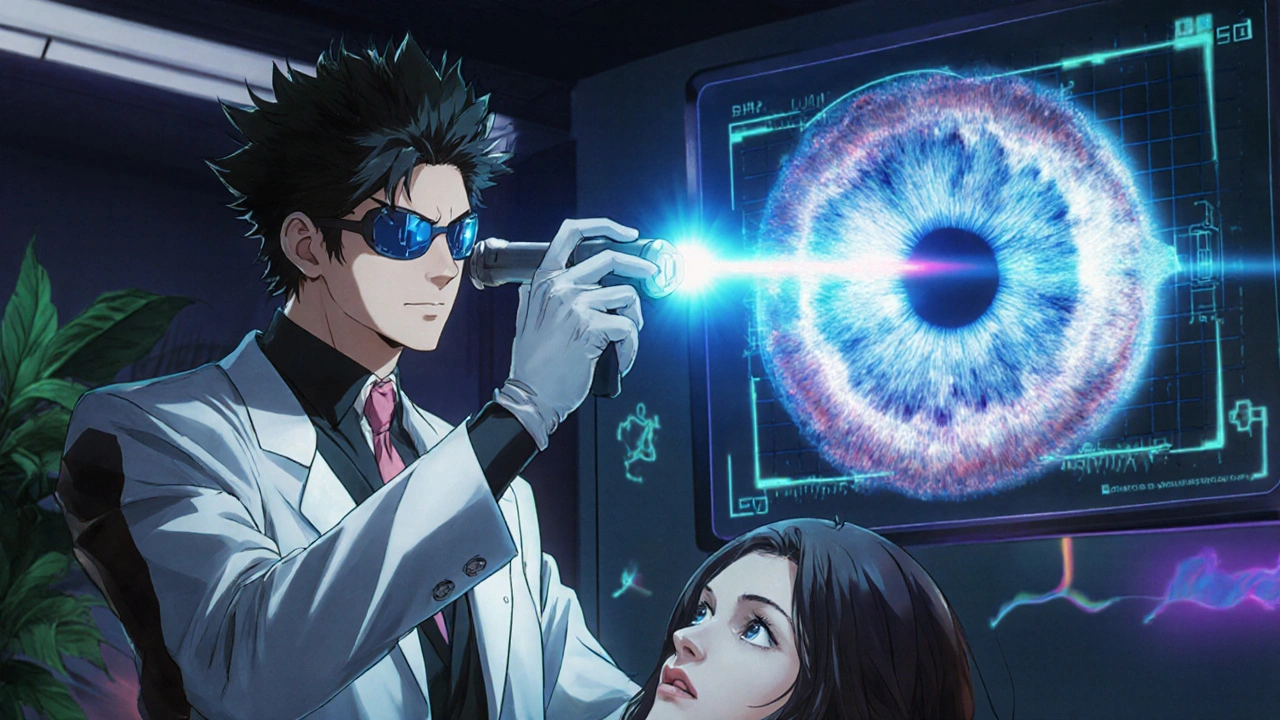Retinal Detachment Risk Calculator
Personalized Retinal Detachment Risk Assessment
This tool helps you understand your risk factors for retinal detachment based on the connection between ocular hypertension and retinal health.
Your Risk Assessment
Your Risk Factors
Recommended Actions
Did you know that people with ocular hypertension is a condition where the fluid pressure inside the eye stays above the normal range without obvious damage to the optic nerve are up to three times more likely to experience a retinal tear that can evolve into a full‑blown detachment? Understanding why this happens can help you spot warning signs early and take steps to protect your vision.
Eye Anatomy Basics
Before we dive into the link, let’s quickly recap the key structures involved. The eye is a sealed sphere filled with fluids that maintain its shape and allow light to focus.
- Cornea is the clear front window that bends incoming light.
- Iris controls the size of the pupil, regulating how much light enters.
- Lens fine‑tunes focus onto the retina.
- Vitreous humor is a gel‑like substance that fills the space between the lens and the retina, keeping the eye’s interior stable.
- Retina is a thin layer of light‑sensitive cells that converts photons into electrical signals.
Two deeper layers are especially relevant to our discussion:
- Choroid supplies oxygen and nutrients to the outer retina.
- Sclera is the tough white outer wall that resists deformation.
What Is Ocular Hypertension?
Ocular hypertension is an intra‑eye pressure (IOP) reading higher than 21 mmHg without detectable optic‑nerve damage or visual‑field loss. Most people with the condition feel fine because the rise in pressure is painless and symptoms often go unnoticed.
Key facts:
- Prevalence increases with age; about 4% of adults over 40 have IOP > 22 mmHg.
- Family history raises risk by roughly 2‑3 times.
- Certain ethnic groups, especially people of African descent, show higher average pressures.
Because the disease is silent, regular eye exams that include tonometry (pressure measurement) are the only reliable way to catch it early.
What Is Retinal Detachment?
Retinal detachment is the separation of the neurosensory retina from the underlying retinal pigment epithelium, cutting off its blood supply. If not repaired promptly, the detached area can become permanently blind.
There are three main types:
- Rhegmatogenous - caused by a retinal tear or hole allowing vitreous fluid to seep underneath.
- Tractional - pull from scar tissue, common in proliferative diabetic retinopathy.
- Exudative - fluid builds up beneath the retina without a tear, often linked to inflammation.
Rhegmatogenous detachment accounts for roughly 85% of cases and is the type most associated with ocular hypertension.
Shared Risk Factors and Overlap
Both conditions share a handful of common risk contributors. Below is a quick comparison:
| Risk Factor | Impact on Ocular Hypertension | Impact on Retinal Detachment |
|---|---|---|
| Age > 50 | Higher IOP prevalence | Weaker vitreous adhesion, more tears |
| Myopia (nearsightedness) | Often associated with thinner sclera | Longer axial length stretches retina, increasing tear risk |
| Family History | Genetic predisposition to high IOP | Inherited collagen disorders can weaken retinal attachments |
| Cataract Surgery | Post‑operative IOP spikes are common | Vitreous shifts during surgery can create retinal tears |
| Inflammatory Eye Diseases | Uveitis can raise IOP temporarily | Inflammation promotes tractional forces |
Notice how several factors-age, myopia, and surgical history-appear on both sides. That overlap is where the link between the two conditions starts to form.

Pathophysiological Connections
Scientists have proposed three main mechanisms that explain why high intra‑ocular pressure might predispose a retina to detach:
- Mechanical Stress on the Sclera - Elevated IOP stretches the scleral wall, which in turn pulls on the peripheral retina. Over time, this tension can create micro‑tears.
- Altered Vitreous Dynamics - When pressure builds up, the vitreous humor can shift forward, exerting traction on the retinal surface, especially in highly myopic eyes where the vitreous is already liquefied.
- Compromised Blood‑Retinal Barrier - Chronic pressure fluctuations may weaken the retinal pigment epithelium (RPE), making it easier for sub‑retinal fluid to accumulate after a tear.
These processes rarely act in isolation; they often combine, creating a perfect storm for retinal separation.
Clinical Evidence and Studies
Several prospective studies have quantified the risk. A 2022 cohort of 3,200 patients with untreated ocular hypertension showed a 2.8% five‑year incidence of rhegmatogenous detachment, compared with 0.9% in a matched normotensive group. Another 2023 meta‑analysis of 12 studies reported an odds ratio of 2.4 for retinal detachment in eyes with IOP > 24mmHg.
While the absolute numbers remain low, the relative increase is significant enough that ophthalmologists now screen high‑pressure patients for peripheral retinal abnormalities during routine dilated exams.
Diagnosis and Monitoring
Early detection hinges on two complementary exams:
- Tonometry - Measures IOP; values above 21mmHg trigger closer retinal surveillance.
- Peripheral Retina Evaluation - Using scleral depression and wide‑field retinal imaging, clinicians look for lattice degeneration, small holes, or vitreous traction.
For patients with known ocular hypertension, a recommended schedule is:
- Comprehensive eye exam every 6months.
- Retinal imaging (Optos or ultra‑widefield) annually, or sooner if symptoms appear.
- Immediate urgent review if you notice flashes, new floaters, or a shadow/curtain in your vision.

Management Strategies
Because the two conditions have different treatment goals, a combined approach works best.
Controlling Intra‑ocular Pressure
First‑line options include:
- Topical prostaglandin analogues (e.g., latanoprost) - reduce aqueous humor production.
- Beta‑blockers (e.g., timolol) - lower fluid formation.
- Selective laser trabeculoplasty (SLT) - a non‑invasive laser that improves drainage.
If medication fails, surgeons may consider minimally invasive glaucoma surgery (MIGS) or traditional trabeculectomy.
Preventing Retinal Detachment
Key actions include:
- Prompt treatment of identified retinal tears using laser photocoagulation or cryotherapy - these create adhesions that seal the break.
- Vitrectomy - removal of the vitreous gel in high‑risk eyes, especially after cataract surgery.
- Regular monitoring for myopic patients; prophylactic laser can be justified when lattice degeneration is extensive.
Patients who have already experienced a detachment often undergo a pars plana vitrectomy (PPV) combined with silicone oil or gas tamponade to re‑attach the retina.
Practical Tips for Patients
- Never skip your scheduled eye‑pressure check, even if you feel fine.
- Report any sudden flashes of light, an increase in floaters, or a curtain‑like shadow in your visual field immediately.
- Maintain a healthy lifestyle - regular exercise and a balanced diet can modestly lower IOP.
- Discuss any family history of glaucoma or retinal problems with your ophthalmologist; it may influence screening frequency.
Future Directions
Research is moving toward personalized risk models that combine genetics, corneal thickness, axial length, and IOP trends to forecast detachment probability. AI‑driven retinal imaging analysis could flag subtle peripheral changes before a tear becomes visible to human eyes.
Meanwhile, newer drug delivery systems-such as sustained‑release IOP‑lowering implants-promise better pressure control with fewer compliance issues, indirectly reducing detachment risk.
Frequently Asked Questions
Can ocular hypertension cause retinal detachment on its own?
High pressure alone rarely tears the retina, but it creates mechanical stress that makes tears more likely, especially when other risk factors (like myopia) are present.
Do I need surgery if I have ocular hypertension?
Surgery is usually reserved for cases where medication fails to keep IOP in the target range. Most patients start with eye drops and laser therapy.
How quickly can a retinal detachment progress?
Progress can be rapid-hours to days-once fluid penetrates under the retina. That’s why immediate medical attention is critical.
Are there lifestyle changes that lower my risk?
Regular aerobic exercise, a diet rich in leafy greens, and maintaining a healthy weight can modestly reduce intra‑ocular pressure. Avoiding high‑impact sports without eye protection also lowers trauma‑related detachment risk.
Should I get screened for retinal tears if my IOP is normal?
If you have other risk factors-high myopia, family history, or prior eye surgery-screening is advisable even with normal pressure readings.
Understanding the hidden connection between ocular hypertension and retinal detachment equips you to act early, safeguard your sight, and collaborate effectively with eye‑care professionals.


Lauren Sproule
October 17, 2025 AT 13:50Thanks for sharing this info i learned a lot
CHIRAG AGARWAL
October 18, 2025 AT 03:43This is just another hype piece with no real data and i dont care
Carissa Padilha
October 18, 2025 AT 17:36It's weird how they always blame pressure but never mention the hidden implants that could be influencing IOP, you know? Some people think the pharmaceutical industry is quietly pushing drugs to keep us dependent. The connection between ocular hypertension and retinal detachment might be a cover-up for a larger agenda. I read somewhere that the data is being filtered by big pharma. Anyway, stay skeptical and keep asking questions.
Richard O'Callaghan
October 19, 2025 AT 07:30I think the article missspells several terms and the info is kindaa confusing. Its imporant to double check the stats they mention. Also the link between pressure and detachment isnt as simpl as they say. Maybe they rushed the publisation.
Alexis Howard
October 19, 2025 AT 21:23Looks like overhyped and the risk is low
Katie Henry
October 20, 2025 AT 11:16Dear readers, I commend the thorough exposition of ocular hypertension and its implications for retinal health. Your diligence in reviewing these findings will undoubtedly empower patients to seek timely evaluation. Let us continue to champion evidence‑based practices and foster proactive ocular care.
Chris Beck
October 21, 2025 AT 01:10We need to protect our eyes and stop outside influence, this is about our nation’s health!!! Simple facts show high pressure leads to tears, no debate needed, keep eyes safe now!!!
Sara Werb
October 21, 2025 AT 15:03This is absolutely mind‑blowing!!! The way they link pressure to a retinal tear is like a thriller plot, and yet it feels like a warning from the shadows!!! I can’t help but feel that there’s something sinister lurking behind the statistics, a hidden agenda perhaps??? The drama of it all is just too much, but we must pay attention!!!
Winston Bar
October 22, 2025 AT 04:56Another boring article trying to scare us about eye pressure. I’m tired of the endless alarms, it’s just a normal part of aging. Why do we keep hearing the same warnings? It feels like a drip, drip, drip of fear.
Rebecca Mitchell
October 22, 2025 AT 18:50You missed the point that lifestyle changes can lower IOP significantly
Roberta Makaravage
October 23, 2025 AT 08:43One must recognize that the ethical responsibility lies with both practitioner and patient; neglecting early detection is a moral failing 😊. Knowledge without compassion is hollow, therefore we must act with both wisdom and heart 🌟.
genevieve gaudet
October 23, 2025 AT 22:36The eye is like a window to the soul, and cultures across the world have revered vision as a sacred gift. When pressure builds, it’s as if a storm gathers behind that window, threatening the delicate tapestry woven by centuries of wisdom. We should honor those traditions while embracing modern science.
Malia Rivera
October 24, 2025 AT 12:30In the grand scheme of our nation's greatness, we cannot afford to overlook ocular health. Yet this article drags its feet, offering little beyond the obvious. Let’s be proud and demand better screening for all citizens.
lisa howard
October 25, 2025 AT 02:23I have to say that the whole discussion about ocular hypertension feels like a saga that never ends.
From the moment I read the first paragraph, I was drawn into a maze of medical jargon and alarming statistics.
The way the author tries to connect pressure to retinal tears is fascinating yet frustrating.
It makes me wonder why we are not taught about these risks in school.
Moreover, the overlap with myopia and family history is something that should spark a national conversation.
I cannot help but notice that many patients ignore their eye exams because they think they feel fine.
This complacency is exactly what fuels the silent progression of disease.
The proposed mechanisms, such as mechanical stress on the sclera, sound plausible but need more evidence.
I would love to see large‑scale trials that confirm these theories.
Meanwhile, the practical tips for patients are useful, especially the advice to watch for flashes and floaters.
However, the article could have emphasized lifestyle changes more strongly.
Regular exercise and a balanced diet are simple steps that can make a difference.
I also think that insurance providers should cover more frequent retinal imaging for high‑risk individuals.
In conclusion, while the information is valuable, it leaves me yearning for deeper insight and actionable policies.
Let us push for better public awareness and research funding so that no one suffers unnecessary vision loss.
Emily (Emma) Majerus
October 25, 2025 AT 16:16Great job on the post! Keep eye‑checks regular and stay proactive.